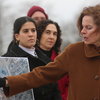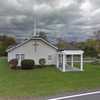Vote set for Nov. 14 on $18.2M building upgrade
The Enterprise — Melissa Hale-Spencer
Head of the class: Superintendent Marie Wiles gives certificates to the principals of Altamont Elementary School, Peter Brabant, at center, and Pine Bush Elementary School, Christopher Sanita, at left. Both schools were designated “Reward Schools” by the State Education Department, demonstrating “the most progress or highest achievement with no significant gaps in student achievement.” “We need to recognize not only the teachers and staff…but also the district office, board of education, and these wonderful parents,” said Brabant, who also recognized Stephen Hadden, the administrator for special education. “At my school, we have a large special-education population,” Brabant said. “I don’t know if there’s anyone left to thank,” quipped Sanita, adding, “We certainly accept this honor proudly.”
GUILDERLAND — The school board Tuesday night took steps towards a proposed $18.2 million building upgrade. The board set Nov. 14 as the date for a public referendum on the project, and also decided the upgrades would not have significant environmental impact.
Both board votes were unanimous.
The project, recommended by a facilities committee, comes in two parts, which will be voted on in two separate propositions on Nov. 14. The first calls for $17.3 million to update the district’s seven school buildings and improve security and teaching technology.
The second proposition, of $846,300, is to renovate the high school auditorium and better light the football field. Those projects will be undertaken only if both propositions pass.
“The board of education is required to identify and mitigate significant environmental impacts,” said Assistant Superintendent for business Neil Sanders, referencing the State Environmental Quality Review Act.
Since the work will be done within current buildings, there won’t be an adverse environmental impact, Sanders told the school board.
Board Vice President Allan Simpson asked what would happen if asbestos were uncovered.
Sanders responded that asbestos would have to be contained, according to a different state law, but SEQRA applied to impacts on the environment, such as erosion, or effects on wetlands or water.
Board member Jennifer Charron asked about “the lake” at Farnsworth Middle School, referring to flooding in the parking lot.
Michael Andrews with CSArch, the architectural firm working on the project, responded, “The lake stays…We’re-directing the water away from it; we’re creating a better situation.”
The board also passed a resolution that will allow it to add second- and third-tier projects if the first-tier projects are completed under budget.
Referring to the most recent bonded project, Sanders said, “We had a very good bidding environment…It allowed us to get ahead.”
If bids do come in under budget again, the excess could also be used to “lower debt in future years,” Sanders said. He said of the resolution, “It gives you discretion in the future…No commitments at this point.”
Colleen O’Connell, who heads the board’s communications committee, said that tri-fold brochures are being printed in-house to describe the project. They will be in blue, white, and gray rather than the usual red, white, and mauve. She described the brochures as “modest” in contrast with glossy fliers that promoted a failed public library expansion.
A “community engagement meeting” will be held on Oct. 29, O’Connell said, using a “world café model” where attendees will circulate among five rooms to hear about different elements of the project — safety and security, technology, upgrades at the five elementary schools, upgrades at the middle school and high school, and the second proposition for the high school auditorium and football-field lighting.
“At this point, we want to educate people,” said O’Connell.
The lion’s share of the first proposition includes $14 million for items like fixing roofs, replacing or upgrading heating systems, paving, replacing floors or windows, and upgrading electrical and plumbing systems.
Another $1.5 million would go for safety and security improvements, including school lobby modifications, more security cameras, door access swipe-card readers, visitor-tracking software, and classroom and office locksets.
Finally, $1.8 million would go for technology improvements with the biggest portion, $618,000, spent on mobile labs. Assistant Superintendent for Instruction Demian Singleton said the elementary schools don’t have space for fixed computer labs and the current mobile labs are in use “every single day,” with not enough access. He also said the state requirement for testing on computers means more are needed.
At Farnsworth Middle School, Singleton said, presentation media is needed.
Infrastructure improvements include uninterruptible power supplies, which, Singleton said, is “critical for secure databases.”
He also said, with the high school and middle school moving to become “wireless environments,” wireless access points are needed, and network switches, installed at Farnsworth in 2005, are “in desperate need of replacement.”
The second proposition includes $553,800 to upgrade the high school auditorium and $292,500 to replace wooden light poles with steel poles and better lights at the football field.
If the public approved both propositions, a Guilderland resident living in a home with a median assessment of $246,500 would pay an estimated $68 annually in taxes for the 15-year life of the bond.
The estimated taxpayer’s cost for the first proposition would be 26.1 cents per $1,000 of assessed valuation; for the second, 1.3 cents per $1,000.
Other business
In other business, the board:
— Heard a presentation from Meighan Frye about a new requirement that all New York homeowners receiving a Basic STAR (School Tax Relief) exemption must register with the state’s tax department in order to get the break in 2014 and years following. The process is meant to prevent fraudulent exemptions.
Frye described the process to register online at www.tax.ny.gov. “It takes two to three minutes,” she said.
“If I can do it on the computer, anyone can,” agreed board member Judy Slack.
The registration deadline is Dec. 31 although Frye said, “People who forget will be given a second chance.”
Elderly residents who receive the Enhanced STAR benefits are not affected by the new registration requirement and neither are new homeowners. Those with questions may call 457-2036 or e-mail ;
— Heard from Singleton that proposed amendments by the State Education Department would provide some flexibility in requirements for districts to provide help for students who performed poorly on last spring’s new state tests. Many more students than previously were judged not proficient in English and math.
“Our administrators and curriculum cabinets are working diligently to prioritize services under these new guidelines,” said Singleton;
— Heard congratulations for Carol Kelly, a science teacher at Farnsworth Middle School, for her leadership on integrating Common Core Learning Standards with Science Content Standards;
— Heard from Sanders that “no areas of non-compliance” were noted in the annual required fire inspection and that re-inspection of asbestos-containing material in school buildings showed “no change in any material condition,” according to a required triennial inspection report. Both reports are available at the district office;
— Heard from Superintendent Marie Wiles that the start of school last Friday was “truly excellent.” She praised the condition of the facilities, the transportation department, the school leaders, teachers, and support staff and said there were “lots of smiles” and “very positive energy across the district”;
— Heard from Wiles about changes to the way the district teaches secondary students who, for medical or disciplinary reasons, can’t attend school during the day. The law requires 10 hours of weekly instruction.
For years, Guilderland students were individually tutored at a cost of about $60,000. Last year, they were taught by high school teachers at PM School, housed at Farnsworth, which ran four days a week from 4:30 to 7 p.m. The PM School, which began in November and ran through June, served 60 students and cost $27,000.
“By all accounts, it was a very, very successful year,” said Wiles.
This year, The PM School will be run out of Pine Push Elementary, which dismisses ahead of the middle school, from 3:30 to 5:30 p.m., all five weekdays;
— Approved three service agreements for students with disabilities, with the Center for Disability Services, with the Housatonic Academy, and with Mary Alice McGrath, teacher of the visually impaired;
— Approved an agreement with Sage Colleges for students of the Estevez School of Education for clinical laboratory experience;
— Accepted donations of physical-education supplies from Judy Kahn, six backpacks with school supplies from the School Systems Federal Credit Union, a drum set from Mr. and Mrs. Fred Polsinelli, and a string bass case from Mr. and Mrs. Joseph Hannan;
— Declared a long list of items, ranging from an upright piano to a push mower, as surplus or obsolete so that they may be sold to the highest bidder.
President Barbara Fraterrigo expressed concern that the computers, 154 were listed, were being disposed of. “It just breaks my heart,” she said, since people in Third World countries could use them.
“It’s a liability issue,” said Sanders, “to be sure harmful metals don’t get in the landfill.”
Joe Reilly, Guilderland’s technology director, said another concern is the content on the hard drive. The only reliable way to “preserve confidentiality,” he said is “to cook the hard drive.”
Jennifer Charron said she noticed 384 new air filters on the list and asked why they were bought.
Clifford Nooney, the building and grounds supervisor, said they were purchased before he worked for the district for units that no longer exist; and
— Met in executive session to discuss grievance proceeding from the Guilderland Employees’ Association.


